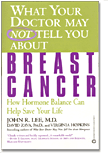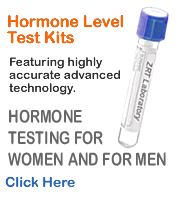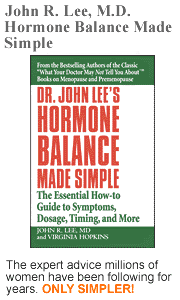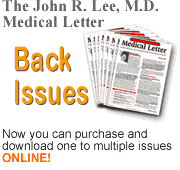|
|
||||
|
For suggestions on how to find a doctor in your area, please go to:  |
||||
|
Breast Cancer Facts: The Nature of Breast Cancer by John Lee, M.D. |
||||
Excerpted From WHAT YOUR DOCTOR MAY NOT TELL YOU ABOUT BREAST CANCER: Chapter Three In spite of what your doctor might tell you, thanks to thousands of studies on cancer done all over the world, right down to the genetic level, we do know a great deal about when, where, how and why cancer begins and progresses. Although there are still some details we still don t entirely understand, cancer is not a complete mystery. If we know so much, then why are we being badly beaten in the “war on cancer?” Aside from the difficulty of changing prevailing medical dogma and treatment, preventing and healing cancer in a big way would entail vast and dramatic changes in lifestyle for Westernized countries. We would have to severely reduce or give up our pesticides. We would need much better control of industrial pollution. We would need to reduce our reliance on plastics that shed estrogen-like chemicals, and other petrochemical products that emit harmful chemicals, such as carpets, furniture and the particle board used to build houses. We would need to drastically reduce our use of prescription drugs, and change the way HRT is prescribed. The use of hormones to fatten livestock and fowl for market and to stimulate milk production in dairy cows, would need to be banned. We would need to cut way back on the amount of processed foods and sugars we eat, and adopt a balanced whole foods diet. We would need to sacrifice some monetary gain to reduce stress levels in our lives. That s the big picture. Now let s move down to the cellular level and fill you in on the basics of what we know about cancer. When Does Cancer Occur? Cancer occurs when normal cells multiply (proliferate) faster than normal, lose their differentiation (remain immature), and have diminished apoptosis (cell death) rates. Don t worry, we ll explain all of this. Cancer cells are primitive in that they haven t grown up and become skin, or bone, or liver or uterus—in medical terms they are undifferentiated. At the stage where they would normally keep developing into a specific type of cell, they divide instead, into another primitive cell. This is because something in the genetics of the cells that gives instructions on how to differentiate, or mature, is broken and has faulty communications. This miscommunication is usually caused by damage or some sort of toxic environment within the cell sufficient to affect the cell s chromosomes (genes). Such damage can result from estrogens, viruses, radiation, genetic predisposition, exposure to toxic chemicals, or injury to the tissue. Most tissues of the human body are not necessarily more susceptible to cancer after being injured, but breast tissue is unique in its combination of vulnerability (e.g. it s not safely tucked away inside the belly like the uterus and ovaries), and in its ability to change in response to hormones. Most women are well acquainted with how quickly their breasts can grow larger (and become tender) premenstrually. Once pregnancy is underway breasts change dramatically. This ability to change undergo rapid growth is one reason that breast cells have greater susceptibility to DNA damage through tissue damage. Cancer biologists are well aware that when a tissue replicates rapidly its genetic code (DNA) is more vulnerable to damage by chemicals, viruses, and radiation that may express itself some years later as cancer.
|
||||

|
What Your Doctor May Not Tell You About Breast Cancer NOW IN PAPERBACK! Another pioneering book by John R. Lee, M.D. that really gets to the bottom of why women get breast cancer and how to prevent it. It covers a wide array of topics including how HRT may trigger breast cancer, why doctors use chemo and radiation even though they don't work very well, what causes breast cancer, how to prevent it, and the remarkably preventive benefits of natural hormones-- when used properly.
|
||||||||




